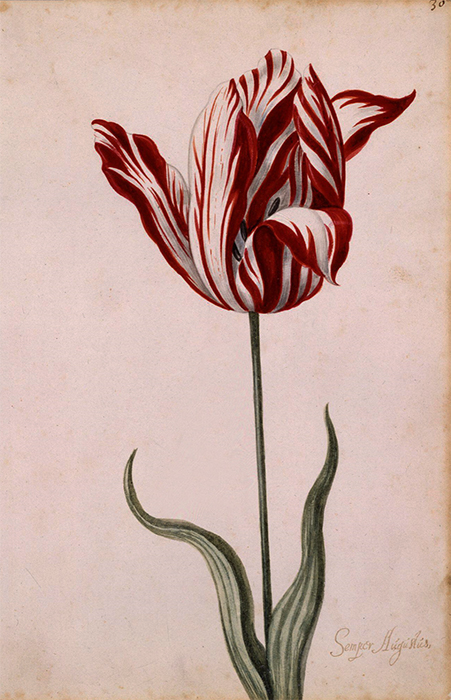
Of all tulip varieties, it was the variegated flowers that most bewitched the Dutch. The contrast in coloring, such as red (Rozen) or purple (Violetten) against a white or yellow ground (Bizarden), was caused by a virus that beautified but also weakened and eventually killed the bulb, as well as its offshoots. A complete mystery at the time, this mosaic or tulip-breaking virus was conveyed by aphids, which flourished in the fruit trees of seventeenth-century gardens. An infected flower was said to be "broken" and there was no way to determine if or when a flower would break. It was an unpredictable phenomenon that only added to the tulip's allure—and appealed, like the market in spices and porcelains, to a culture of risk taking and the inherent gamble in trading such rare commodities. In 1635, one dealer offered a General Gouda for sale, wagering that if a certain fortress then in enemy hands were not retaken in six months, the buyer could have the bulb for free; if it were, he would have to pay 650 fl.
With blood-red flares vividly streaked on a white ground, the color displayed as thin feathers or flames symmetrically running along the center and flakes of the same color at the edge of the petals, Semper Augustus was by all accounts a most remarkable flower and one celebrated at the time for its beauty and rarity. And because it was desirable, it was costly, and because it was scarce, it was coveted. Indeed, by the time the market for such exotic tulips collapsed in February 1637, the number of bulbs probably was not much greater than it had been originally.
In 1623, Nicolaes van Wassenaer, a chronicler of the period, visited the garden of Adriaen Pauw, then the pensionary (town official) of Amsterdam and later grand pensionary of Holland. It was "full of many different Tulips; in the middle of them was a Cabinet surrounded with mirrors which threw back the reflection of the Flowers so elegantly that it seemed like a Royal throne." (Gardens of the time had much more open space between the flowers.) Of them all, it was Semper Augustus that struck Wassenaer's fancy. "The colour is white, with Carmine on a blue base, and with an unbroken flame right to the top. Never did a Blommist see a more beautiful one than this: no Tulip has ever been in greater esteem." When a bulb that had sold for 1,000 guilders was found to have two offsets at lifting, the owner actually felt cheated, realizing that he could have sold it for three times the price the next year.
The following spring, in 1624, Wassenaer again wrote about Semper Augustus. Only a dozen examples even existed, all owned by a single individual, whose name he does not disclose but who refused to part with any of them, even though each one would have cost 1,200 guilders—a price that would remain high only if he did not sell. The next year, Wassenaer reported that 2,000 and then 3,000 guilders had been offered for a single bulb but the owner still could not make up his mind what to do. If this mysterious connoisseur (liefhebber) was, in fact, the fabulously wealthy Pauw, who was a director of the Dutch East India Company, money would not have been as important as the flower's beauty. But this obduracy must have made it even more coveted. A Semper Augustus weighing 200 asen (a third of an ounce) was said to have sold for 5,500 guilders in 1633. Just before the crash, a price of 10,000 guilders was being asked—an exorbitant amount that would have purchased a grand house on the most fashionable canal in Amsterdam, or clothed and fed an entire Dutch family for half a lifetime.
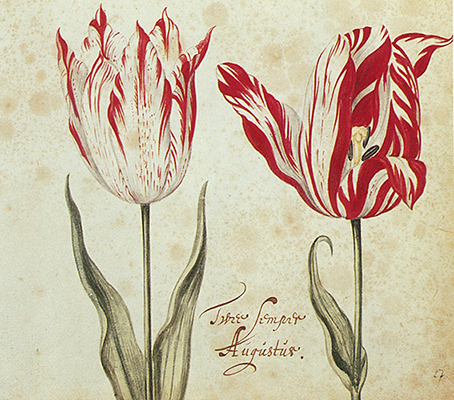
This watercolor of two different examples of Semper Augustus is from the Brandemandus tulip book.
The two below are by Pieter Holsteyn the Younger (c. 1612–1673). The first comes from a tulip book, an album of flowers that was used by commercial growers as a sales catalog (or sometimes commissioned by wealthy gardeners to record the flowers in their garden). Unlike a still life, the portraits are quite plain, in which the flower, sometimes with its name, appears against an off-white background. Nor is the bulb depicted, as it would have been in a botanical illustration. Curiously, the prices recorded in some portraits were not the ones actually being charged—but those of the Alkmaar auction on February 5, 1637 (when the very highest prices had been paid), presumably copied out to please those who owned the same variety of bulb. The other shows a Semper Augustus in which the pale yellow ground (rather than white) has broken through.
The folly of tulipmania was satirized in Three Dialogues between Waermondt and Gaergoedt, Being the Continuation of the Rise and Decline of Flora, a pamphlet published in Haarlem in 1637. Over an expensive bottle of brandy, Gaergoedt, a weaver, boasts in the First Dialogue that florists (bloemisten as he now considered himself) live in contented joy and have everything they need—"for a little flower can pay for it all," as it had done for the brandy.
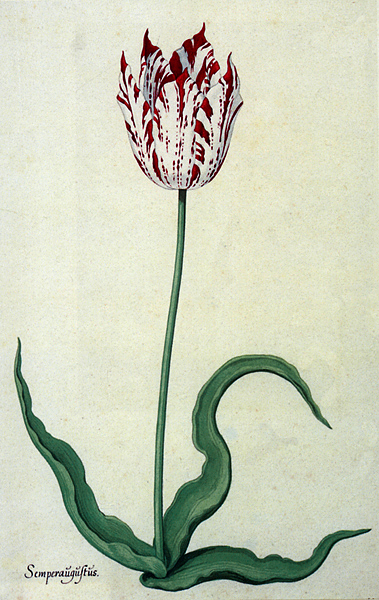
In the Third Dialogue, the conversation turns to Semper Augustus.
Waermondt [True Mouth]: I have often wanted to ask you what kind of flower is the Semper Augustus of which I have heard so much?
Gaergoedt [Greedy Goods]: That it is a beautiful flower; one can but see it at the homes of only two people, one in Amsterdam from which it comes, and also here [Haarlem] at the home of one who will not sell for any money [the connoisseur]; so they are in close hands.
Waermondt: At how much is such a flower estimated?
Gaergoedt: Who shall say? But I will tell you what I have heard about it: about three years ago, it was sold for 2,000 gld., transferred at once at the Bank, with the restriction that the buyer could not sell or alienate it without the consent of him from whom he bought it.
Waermondt: So they might have been worth this winter, say, 3,000 gld.
Gaergoedt: Yes, even 6,000, and possibly more, even if it be a plant of only 200 aces.
Waermondt: The flowers greatly surpass gold and silver.
Gaergoedt: You may say gold and silver, yes, all the pearls and costly stones.
Waermondt: It is true, if you consider their beauty when in existence and take into account by whom the trade is run. But not when you look at their perishability, and consider by whom silver and gold, pearls and stone, and artistic works are esteemed; because the latter are esteemed by great people, the former by common folk.
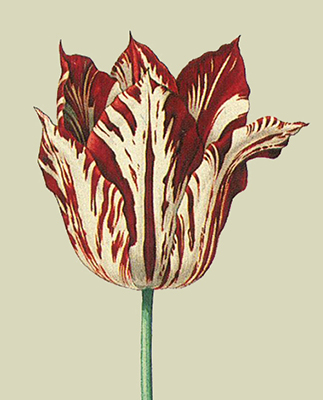
The basic unit of currency in the Dutch Republic was the guilder, denoted by fl. (florin, ƒ) and comprising twenty stuivers. In 1638, it had a gold content of 0.77 grams (0.027 ounces). The Semper Augustus that purportedly sold for 5,500 fl. would have had an equivalent value in gold equal to $178,200 (if evaluated at $1,200 per ounce) at a time when such purchasing power would have been much greater. Although it is difficult to make meaningful comparisons between monetary values in the Dutch Republic in the first half of the seventeenth century and the present, salaries and prices do provide an index. The annual wage of a cloth shearer or carpenter, for example, was about 250 fl.; a master carpenter in Alkmaar might earn a bit more than a guilder per day or about 438 fl. a year; a well-to-do merchant, from 1,500 to 3,000 fl. annually. Carolus Clusius, while at the University of Leiden, had a salary of 750 fl. per year. The fee charged by Rembrandt for his imposing masterpiece The Night Watch (1642) was about 1,600 fl., the members of the militia each paying an average of 100 fl. to be included in the group portrait, depending upon their placement.
The florin itself originated in Florence and derives, ironically enough, from fiorino, Italian for "little flower"—in this case, the lily (in the form of a fleur-de-lis), the symbol of Florence (Fiorentia) that appeared on the obverse of the coin. Guilder derives from the Dutch gulden, meaning "golden," a description of the original gold coin.
If compared to contemporary commodity prices in January 1637, 1,000 guilders would have bought either 4,651 pounds of figs, 3,448 pounds of almonds, 5,633 pounds of raisins, 370 pounds of cinnamon, 25,491 pounds of rye bread, 13.4 vats of butter, 111 tuns of Bordeaux wine, 5,714 pounds of meat—or a small house in Haarlem.
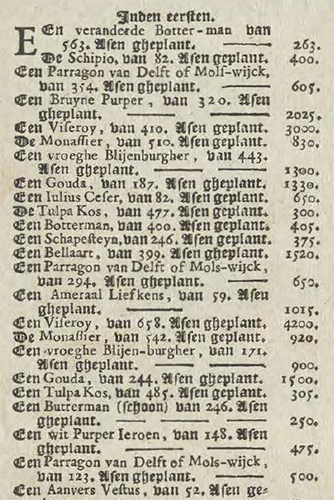
The highest reliably attested amount paid for a single tulip bulb was for an Admirael van Enkhuizen (with an offset), a Violetten that sold at Alkmaar for 5,200 fl. It was one of approximately seventy rare bulbs auctioned that day to support the orphaned children of Wouter Winkel, a tavern owner who had managed to grow some of the most desirable tulips in Holland (of which the Admirael was the most prized). Sold privately before the auction began, it was one of several lots totaling 21,467 fl. purchased by a single wealthy buyer. Almost 53,000 fl. more were paid for Winkel's remaining bulbs, including a heavy Viceroy bulb that sold for 4,200 fl., the most paid at the auction itself. In all, 90,000 fl. were realized (the equivalent in 2013 of approximately 2,240,907 fl.)—the prices for the different varieties representing in almost every case the highest amounts ever recorded.
In terms of guilders paid per aes, the most expensive bulb was an Admirael Liefkens, which weighed 59 asen and sold for 1,015 fl. or 17 guilders four stuivers per aes. This is an extraordinary amount, given that the bulb weighed only one-tenth of an ounce. Gold itself was valued at 37 fl. per ounce, the bulb at 10,150 fl.—more than 274 times greater. Truly, as Waermondt remarked, tulips "greatly surpass gold and silver," which was seconded by Gaergoedt, "yes, all the pearls and costly stones."
So extravagant were these prices that they were printed in wonderment on a broadside (Lijste van Eenighe Tulpaen Verkocht aende Meest-Biedende, "List of Some Tulips Sold to the Highest Bidder," above). Even the average price of the bulbs sold that day represented two years' pay for a master carpenter in Leiden. A tulip book also had been commissioned to promote the sale, with watercolor illustrations of 124 tulips from Winkel's garden, showing the flowers that were expected to bloom. Once owned by E. H. Krelage (below), it sold at Christie's on November 13, 1995 for $90,471.
But almost simultaneously, the market was collapsing. Two days before, in Haarlem to the south, there were rumors that the bulbs being offered had no bidders.
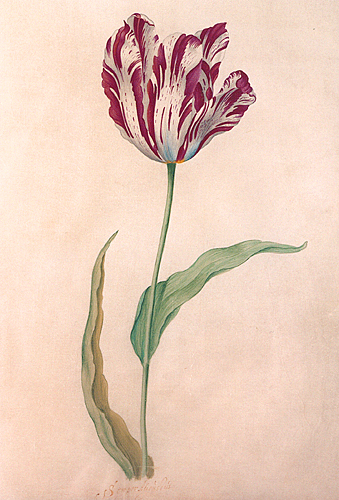
Tulips were among the first flowers to be given special names, and in the Dutch Republic often were christened by breeders and connoisseurs desirous of perpetuating their own identity as collectors and elevating their status in society. Often, too, growers sought to make their tulips more desirable simply by the prestige of the names given them. Some were designated General (scarlet-striped tulips on a white ground) or Admiral (red-striped). The Admirael van Enkhuizen was named after one of the first towns to have revolted against Spain in the Eighty Years' War (1568–1648) and likely was where the tulip had been bred.
As well as beauty, novelty and uniqueness were important considerations in a purchase, the value of the tulip inferring the self-worth of its owner. The desire was to be known and remembered, even if the flower itself was ephemeral. The figure in Rembrandt's The Anatomy Lesson of Dr. Nicolaes Tulp (1632), for example, is that of Claes Pieterszoon, who added Tulp to his name from the sign of the tulip on his house. And when a house purportedly sold in 1633 for three rare bulbs, the transaction was commemorated by three tulips being carved on its façade in an exchange that presumably was between the already wealthy and not a cautionary tale of a simple farmer imprudently selling his family home.
A picture of flowers need not always be allegorical, didactic, or moralizing, however. It simply could be representational and reflect an objective interest in the natural world, fixing what was transient and preserving what otherwise would fade. Too, a picture allowed flowers that otherwise would have bloomed at different times of the year to be collected together for a still-life portrait, the rarity and beauty on display a testament to the owner's possessions. The tulips themselves always were the most flamboyant, all flames and feathers. So desirable were the rarest tulips that it could cost less to commission a painting by one of the most famous artists of the day than to own one or two of the flowers themselves.
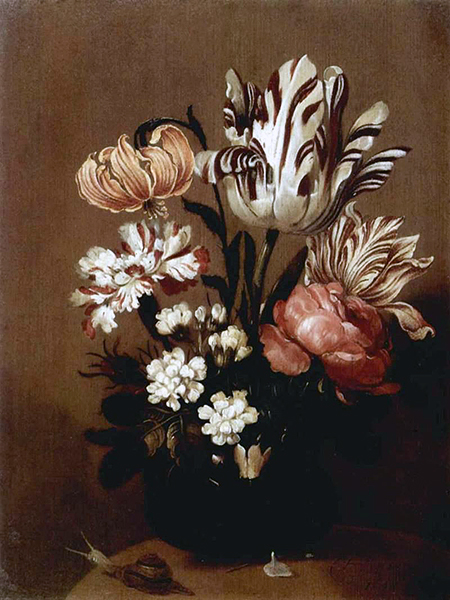
This still life by Hans Bollongier (1644), which is in the Frans Hals Museum (Haarlem), arranges the flowers according to the taste of the time, with the most beautiful or rarest crowning the bouquet, which splays out at the top. So heavy as almost to fall over, Semper Augustus is proudly displayed, its petals curling, the petal of another flower already having dropped. Together with the snail crawling across the table, it was a reminder that even the most beautiful object is mutable and eventually will die. Quickly losing its bloom, the flower was an almost obligatory reminder of the brevity and vanity of life. Here, the bouquet is imaginary, its flowers not all blooming at the same time.
A bibliographic note: Nicolaes van Wassenaer was a physician from Amsterdam who published Historisch Verhael aller Gedencwaerdiger Gheschiedenissen die in Europa ("Historical Account of All the Most Remarkable Events Which Have Happened in Europe"), a collection of twenty-one pamphlets that appeared twice a year from 1621 to 1632. Whereas his accounts dealing with the history of New Netherland, including New York State, have been translated in their entirety, those relating to Semper Augustus (April 1623, June 1624, April 1625) are more fragmentary. Wassenaer does not identify the connoisseur who owned the bulbs, but Pavord assumes that he was Adriaen Pauw, to whom she attributes a later sale in the remark by Gaergoedt that a Semper Augustus was sold for 2,000 guilders with the stipulation that it not be resold without permission. This was in 1634, about three years before the Dialogues were published. Gaergoedt also declares that only two people possessed the flower, one of whom lived in Amsterdam, the other in Haarlem, where Pauw had a magnificent estate.
One sometime reads that 10,000 fl. actually were paid for a Semper Augustus. It is an impossibly large sum, but there are several unreferenced passages to support it. Citing an account by E. H. Krelage (whose grandfather had founded a famous nursery of the same name in 1811 and who once had owned the 1637 tulip book of P. Cos), Dash notes that a collector from Amsterdam sold a Semper Augustus bulb to a colleague in Haarlem on the condition that no more be sold without their mutual consent. When the Amsterdammer then sold a bulb for 3,000 fl. and a "Spaansch kabinet" worth 10,000 fl., the Haarlemmer in turn sold three bulbs for 30,000 fl.—the equivalent of three grand houses on an Amsterdam canal.
Another transaction is recorded by Munting who, writing in 1671, relates that a Semper Augustus weighing only 123 asen sold for 4,600 fl., including a well-constructed carriage and two dapple-gray horses with harnesses. The most excessive price appears in a brief item on the flower trade in Holland in Het Nederlandsch Magazijn (1838), where a price of 13,000 fl. is mentioned without attribution (p. 15).
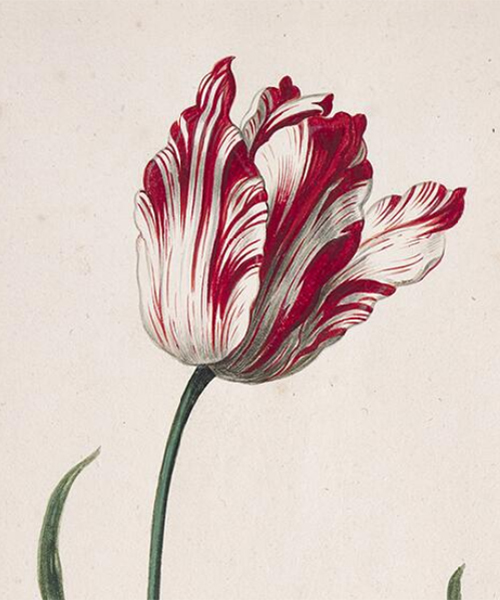
This detail is of another striped Rozen, an Admirael der Admiraels de Gouda weighing 224 asen that sold for 1,500 fl. Like the Generael der Generaelen van Gouda, it was thought that, if an Admirael or Generael were superlative, then how much more so must be an "Admiral of Admirals" or "General of Generals."
A Generael der Generaelen van Gouda, in fact, increased in value by two-thirds in a single twelve-month period (December 1634 to December 1635), by half again between December and May 1636, and then tripled yet again between June 1636 and January 1637. In just two years, the value of the bulb soared from 100 to 750 guilders.
Both the Semper Augustus (top) and the Admirael (above) are from a seventeenth-century tulip book in the Norton Simon Museum (Los Angeles).
Ironically, the very beauty of Semper Augustus is why it no longer exists. The vivid markings caused by the tulip breaking virus also weakened the bulb (and its offshoots), stunting the plant and causing it to wilt. With little energy to multiply or blossom, propagation becomes increasingly difficult; eventually, the bulb cannot flower and becomes extinct. It is to restrict this virus that infected bulbs no longer tend to be commercially sold, certainly not in the Netherlands where there is justifiable fear that the virus will spread to other flowers, such as lilies. A few breeds, however, such as Zomerschoon, which has existed since 1620, continue to bepropagated, even though infected.
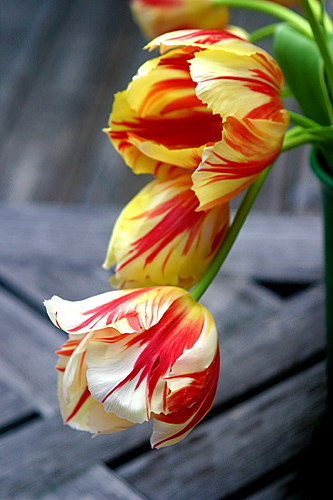
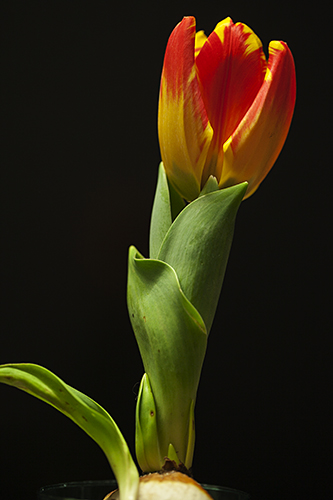
Variegated cultivars (Rembrandt Tulips) still can be enjoyed, however. The more moderate climate of northern California permits the blooms to appear as early as mid-March, although the winters are far too mild to store the bulbs without refrigeration
Too often, when a bulb is planted, only the flower can be admired. To lift the bulb, however, and bring it inside reveals so much more than the blossom. Put in water and placed in the sun, the petals sheltered from wind and rain (and the occasional deer), what was hidden now is revealed: the tracery of roots, the unfolding leaves, and hidden offsets.
References: Tulipomania (1999) by Mike Dash; The Tulip (1999) by Anna Pavord; "Tulipmania" (1989) by Peter M. Garber, The Journal of Political Economy, 97, 535-560; "The Tulip Mania in Holland in the Years 1636 and 1637" (1929) by N. W. Posthumus, Journal of Economic and Business History, 1, 434-466 (a translation of "De Speculatie in Tulpen in de Jaren 1636 en 1637" originally published in Economisch-Historisch Jaarboek in 1926); Tulipmania: Money, Honor, and Knowledge in the Dutch Golden Age (2007) by Anne Goldgar; The Tulip Anthology (2010) edited by Billie Lythberg; Tulips (1912) by Joseph Jacob (at the time, the first book in English on the subject); Bloemenspeculatie in Nederland: De Tulpomanie van 1636-37 en de Hyacintenhandel (1942) by E. H. Krelage; Waare Oeffening der Planten (1671) by Abraham Munting; Naauwkeurige Beschryving der Aadgewassen (1696) by Abraham Munting (this is an expanded version of Waare Oeffening der Planten); Tulips Portrayed: The Tulip Trade in Holland in the 17th Century (1992) by Sam Segal.
See also Conchylomania and Floralia.